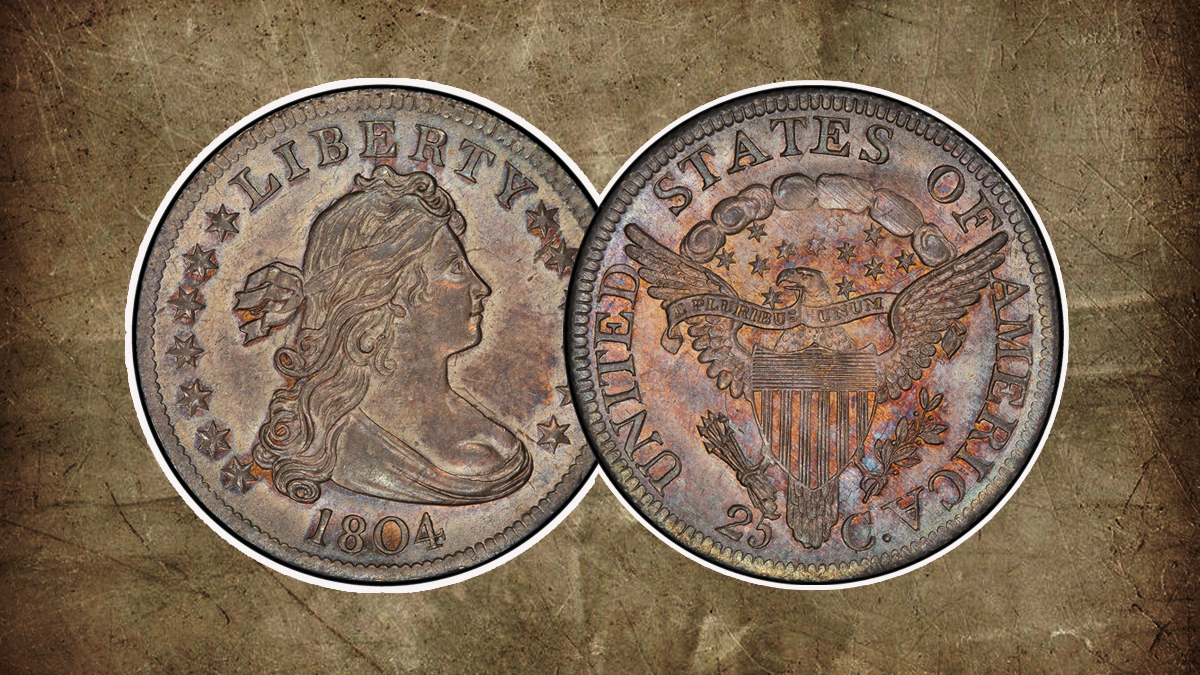
In American numismatics, the 1804 Draped Bust Quarter has become especially important. It represents a period of early American currency that attracts collectors and history enthusiasts both due to its low mintage and its historical significance. The article explores the 1804 Draped Bust Quarter’s history, specifications, design, rarity, state, and value.
History of 1804 Draped Bust Quarter
In 1796, the United States Mint introduced the Draped Bust design on the nation’s first quarter dollar. But during this first phase of production, and the production and circulation of quarter-dollars stopped until 1804. The Spanish two-real coins, which had the same financial goal as the quarter of a dollar, were utilized so extensively that they generated production delays. The competition reduced the manufacturing of US quarter dollars until the devaluation of all foreign coins in 1857. The production of quarter dollars restarted with the 1804 issue, utilizing the newly developed Heraldic Eagle reverse design, and it continued till 1807.
Specifications
- Designer: Robert Scot
- Mint: Philadelphia
- Composition: 89.2% Silver, 10.8% Copper
- Weight: 6.74 grams
- Diameter: 27.50 millimeters
- Edge: Reeded
- Mintage: 6,738
Basic Design
Obverse: Gilbert Stuart, the artist, designed and Robert Scot, the engraver, made the Draped Bust of Liberty on the obverse. A historically draped lady with flowing hair, Liberty is covered by stars which stand in for the initial states and the phrase “LIBERTY.”
Reverse:
In reverse First established in 1804, the reverse design includes the Heraldic Eagle, which is a representation of the United States Great Seal. The eagle holds arrows and an olive branch, which represent for ready for battle and peace, respectively. Thirteen stars and the banner with the phrase “E PLURIBUS UNUM” appear above the eagle. At the bottom, the denomination “25 C.” is written.
Also Read – 10 Most Valuable Quarters
Rarity and Condition
In all grades, the 1804 Draped Bust Quarter is extremely rare. Because just 6,738 of those coins were manufactured, most circulated pieces are difficult to come by up with. The 1804 quarter is significantly more challenging to find in any condition, yet the 1796 quarter is famous for its high-grade making.
High-Grade and Mint State Examples: It can be hard to find an 1804 quarter in Mint State or nearby it. The adjustment lines are common, but unless they are very obvious, they generally do not significantly affect the grade. High-grade examples frequently show focus strength because of striking issues.
Coins in Circulated Grades: The 1804 quarter often has varying wear in circulated grades, including some destruction of the text and stars. It’s hard to find coins without scratches, edge wounds, or other mutilations.
1804 Draped Bust Quarter Value
The value of an 1804 Draped Bust Quarter is highly dependent on its condition. High-quality coins may fetch prices associated with their rarity and historical value. For example, an AU55-grade coin brought $80,000 at auction in 1980, showing the strong demand for this kind of coin among collectors. Lower-grade variants are nonetheless highly sought-after while being difficult to find due to the coin’s rarity.
Also Read – 1870 CC Liberty Seated Quarter: A Numismatic Rarity
Conclusion
The 1804 Draped Bust Quarter is an important coins of early American coinage that collectors appreciate high. Its unique design, low mintage, and historical value make it an essential element of any numismatic collection. This coin represents the spirit of the US Mint’s early achievements and the rich history of US currency, whether it is in a higher grade or is regularly circulated.
